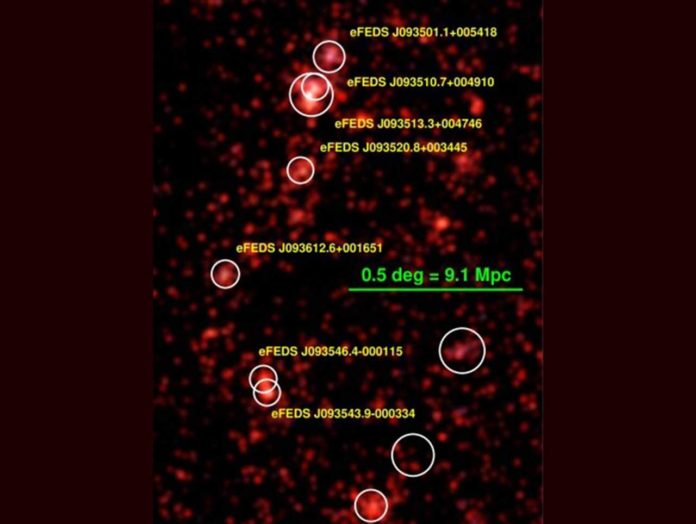Superclusters are among the largest structures in the known universe. Their discovery could pave the way towards a better understanding of large cosmic filaments’ formation and evolution.
Recently, a group of astronomers led by Vittorio Ghirardini of the Max Planck Institute for Extraterrestrial Physics in Garching, Germany, reports the discovery of a new supercluster. The structure was identified by analyzing the data from the eROSITA Final Equatorial Depth Survey (eFEDS).
What’s more, the newly discovered structure consists of eight galaxy clusters at a redshift of 0.36. The observations show that the northernmost clusters of this structure are going through an off-axis significant merger activity. Optical and X-ray data suggest a triple merging system with a double merger and a pre-merger.
Astronomers noted, “We analyze the 140 deg2 eROSITA Final Equatorial Depth Survey (eFEDS) field, observed during the Performance Verification phase to a nominal depth of about 2.3 ks. In this field, we detect a previously unknown supercluster.”
The cluster designed eFEDS J093513.3+004746 is located at the northern part of the supercluster is the most massive and luminous one of the eight. It is also one of the most enormous and luminous clusters in the whole eFEDS field. Its mass was determined to be 580 trillion solar masses.
The least massive clusters of this supercluster, eFEDS J093546.4-000115, and eFEDS J093543.9-000334, have masses of around 130 trillion solar masses. The masses of the remaining five clusters are assessed to be between 140 and 250 trillion solar masses.
Moreover, the information uncovered two radio relics in the north and southeast region of the northernmost clusters and an extended radio halo, which likewise bolsters the ongoing merger activity scenario.
Astronomers noted, “The presence of an elongated radio halo connecting two radio relics in eFEDS J093513.3+004746 and eFEDS J093510.7+004910 indicates that the cluster is undergoing a major merger. This is supported by the galaxy density contour map that shows two peaks in the north and south regions of the cluster system.”
Journal Reference:
- Discovery of a Supercluster in the eROSITA Final Equatorial Depth Survey: X-ray Properties, Radio Halo, and Double Relics, arXiv:2012.11607 [astro-ph.CO] arxiv.org/abs/2012.11607
